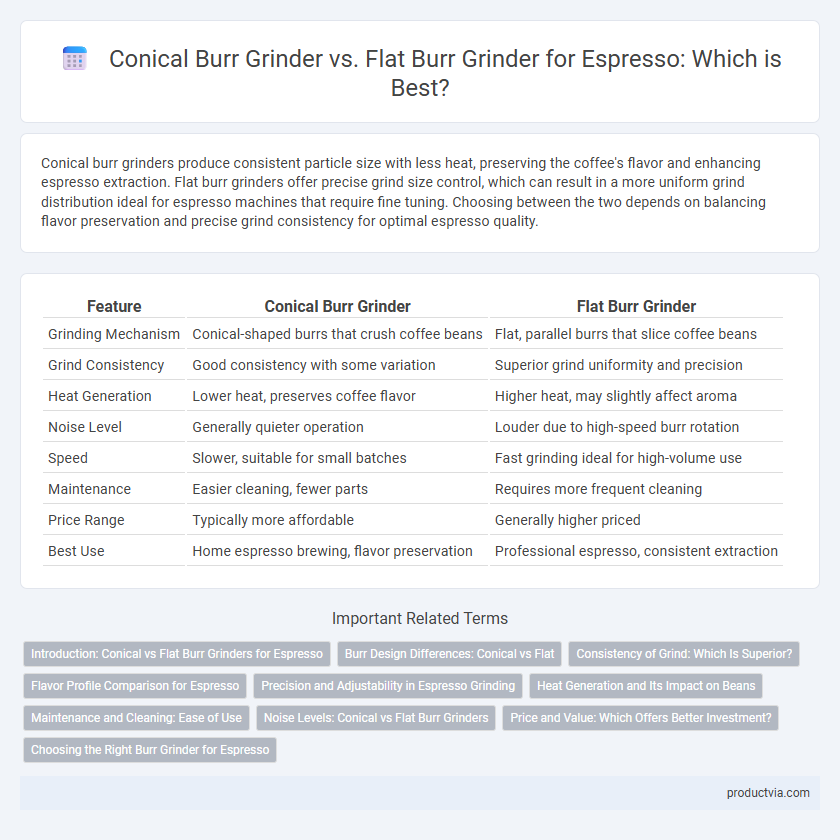Conical burr grinders produce consistent particle size with less heat, preserving the coffee's flavor and enhancing espresso extraction. Flat burr grinders offer precise grind size control, which can result in a more uniform grind distribution ideal for espresso machines that require fine tuning. Choosing between the two depends on balancing flavor preservation and precise grind consistency for optimal espresso quality.
Table of Comparison
| Feature | Conical Burr Grinder | Flat Burr Grinder |
|---|---|---|
| Grinding Mechanism | Conical-shaped burrs that crush coffee beans | Flat, parallel burrs that slice coffee beans |
| Grind Consistency | Good consistency with some variation | Superior grind uniformity and precision |
| Heat Generation | Lower heat, preserves coffee flavor | Higher heat, may slightly affect aroma |
| Noise Level | Generally quieter operation | Louder due to high-speed burr rotation |
| Speed | Slower, suitable for small batches | Fast grinding ideal for high-volume use |
| Maintenance | Easier cleaning, fewer parts | Requires more frequent cleaning |
| Price Range | Typically more affordable | Generally higher priced |
| Best Use | Home espresso brewing, flavor preservation | Professional espresso, consistent extraction |
Introduction: Conical vs Flat Burr Grinders for Espresso
Conical burr grinders feature two cone-shaped burrs that produce a consistent grind size ideal for espresso, preserving the coffee's aromatic oils and enhancing flavor extraction. Flat burr grinders use two parallel wheels to crush beans uniformly, offering precise particle size control that ensures balanced espresso shots. Choosing between conical and flat burr grinders depends on preferences for grind consistency, flavor profile, and maintenance requirements in espresso preparation.
Burr Design Differences: Conical vs Flat
Conical burr grinders feature two cone-shaped burrs that fit one inside the other, allowing coffee grounds to be crushed in stages, which enhances flavor consistency and reduces heat generation. Flat burr grinders consist of two parallel, flat burrs that produce uniform particle size but may generate more heat due to higher rotational speeds. The burr design differences impact the grind texture, extraction precision, and ultimately the espresso's taste profile.
Consistency of Grind: Which Is Superior?
Conical burr grinders offer superior consistency for espresso due to their ability to grind beans more uniformly with less heat buildup, preserving flavor integrity. Flat burr grinders produce a more precise particle size distribution but can generate more heat, potentially affecting espresso quality. For espresso enthusiasts prioritizing grind consistency and flavor clarity, conical burr grinders generally provide a more reliable extraction.
Flavor Profile Comparison for Espresso
Conical burr grinders produce a more consistent grind size with fewer fines, resulting in espresso that highlights brighter, more nuanced flavors and a cleaner cup profile. Flat burr grinders generate a higher proportion of fines, which can enhance crema and deliver richer, bolder espresso shots with pronounced body and intensity. Choosing between conical and flat burrs ultimately influences the espresso's flavor balance, clarity, and mouthfeel, catering to different taste preferences.
Precision and Adjustability in Espresso Grinding
Conical burr grinders offer superior precision in espresso grinding due to their design, which allows for consistent particle size and reduced heat buildup during grinding. Flat burr grinders provide excellent adjustability with micrometric settings, enabling fine-tuned control over grind size essential for espresso extraction. Both types enhance espresso quality, but conical burrs excel in precision while flat burrs prioritize adjustability for taste customization.
Heat Generation and Its Impact on Beans
Conical burr grinders generate less heat due to their slower grinding speed and efficient design, preserving the delicate oils and flavors essential for a rich espresso. Flat burr grinders tend to produce more heat because of higher RPMs, which can lead to premature bean scorching and altered taste profiles. Excessive heat during grinding negatively impacts the bean's aroma and acidity, making conical burr grinders preferred for maintaining bean integrity in espresso preparation.
Maintenance and Cleaning: Ease of Use
Conical burr grinders require less frequent cleaning due to their design, which naturally directs coffee grounds downward, minimizing residue buildup and making maintenance simpler. Flat burr grinders often accumulate more coffee particles between the burrs, necessitating more frequent and thorough cleaning to maintain optimal performance. Ease of use in maintenance generally favors conical burr grinders, as their design enables quicker disassembly and more accessible cleaning of burrs and chambers.
Noise Levels: Conical vs Flat Burr Grinders
Conical burr grinders tend to produce less noise compared to flat burr grinders due to their slower rotational speeds and more efficient grinding process. The quieter operation of conical burrs makes them preferable in home environments or small cafes where noise reduction is important. Flat burr grinders generate more noise as their high-speed rotation and tightly aligned burrs create increased friction during espresso grinding.
Price and Value: Which Offers Better Investment?
Conical burr grinders typically offer more affordable price points while maintaining consistent grind size, making them a valuable investment for espresso enthusiasts seeking quality without a high cost. Flat burr grinders, although often priced higher, provide superior grind uniformity and precision, resulting in enhanced espresso extraction and flavor complexity. Considering price and value, conical burr grinders deliver excellent entry-level performance, whereas flat burr grinders justify their premium through long-term consistency and professional-grade results.
Choosing the Right Burr Grinder for Espresso
Conical burr grinders provide consistent particle size and retain heat less, making them ideal for preserving espresso flavor complexity. Flat burr grinders offer uniform grind size and generate slightly more heat, which can impact the taste but enhance extraction precision. Selecting the right burr grinder depends on preferences for flavor clarity and grind consistency in espresso preparation.
Conical burr grinder vs Flat burr grinder for espresso Infographic

 productvia.com
productvia.com